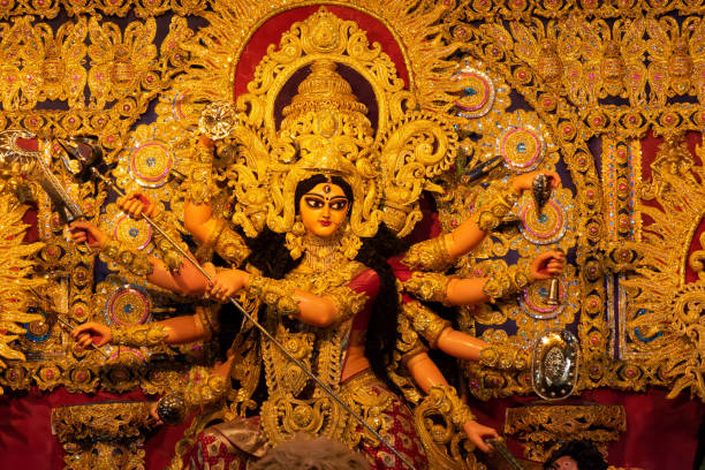
Navarātri: nine nights of the Goddess
A course about the the yearly celebration of feminine power and kuṇḍalinī śakti as understood through the devotional study of the Devī-Māhātmya
Navarātri means "nine nights" and refers to a celebration that takes place several times per year in honor of the great Goddess, she who is known as Śakti (translated as power, energy, creative capacity or capability).
The most known and widely celebrated of the yearly "nine nights" is the one that falls in the autumn and which is called Śāradā Navarātri. During this time, millions of devotees honor the Goddess in the form of Durgā ("she who is reached through difficulty" or "she who is impossible to conquer"), a fierce demon-slaying warrioress. Though Durgā is worshipped as the great Mother of the Universe (Jagadambā) she is simultaneously understood to be kuṇḍalinī śakti, or the power of awakening, inside of the individual.
For practitioners of Yoga and Tantra, this means that Navarātri is a great time to do sādhanā (spiritual practice), in order to call on the grace that awakens us to our true nature.
Traditionally, a śakta (Goddess-oriented) text called the Devī-Māhātmya ("the glory of the Goddess") is recited during this time. The text contains three stories of how the Goddess conquers demonic forces and restores dharma (divine order or righteousness) to the world. Though inspiring as stories of the eternal fight between good and evil, these myths are better understood (in a nondual manner) as mirrors of our inner spiritual processes.
In images of Durgā worshipped during Navarātri, one often sees her surrounded by or emanating the goddesses Kālī, Lakṣmī and Sarasvatī. These goddesses are understood to represent different phases (or faces) of kuṇḍalinī śakti and to have their respective seats in different areas of the practitioner's body. During Navarātri they are each worshipped for three days/nights of the nine.
Other images show Durgā surrounded by nine goddess forms (the Navadurgā)- one for each night/day of the celebration. Knowledge about all of these forms of the Goddess is given in the course, although special attention is given to Kālī, Lakṣmī and Sarasvatī.
Students who join this course will:
* Learn about the meaning of Navarātri and how it is celebrated
* Be introduced to the foundations of Śakta Tantra and its philosophy and cosmology
* Understand the historical development of the term kuṇḍalinī
* Study the Devī-Māhātmya and decode its esoteric meaning
* Learn about the Navadurgā (the nine forms of Durgā)
* Listen to mythological stories about Durgā, Kālī, Lakṣmī and Sarasvatī
* Be introduced to numerous mantras to invoke and embody the Goddess
* Experience powerful Goddess meditations
If you feel curious about or have been called to start or perhaps reignite your Goddess practice, this course is for you! Through devotional storytelling, philosophical discussion, mantra recitation and meditation we will approach the source of all power, all energy and all creativity. I hope that you will join us! Jai Ma! Victory to the Invincible One!
Your Instructor

Tova Olsson is a scholar of religion, author and yoga teacher with over 20 years of experience in educating. She is appreciated for her deep knowledge, her ability to explain esoteric ideas and philosophical concepts in an accessible way, for her skillful storytelling and humorous approach. As a scholar-practitioner, she strives to combine academic, critical understanding with the dedicated experience of a long-term practitioner, offering courses that provide liberating knowledge - on many different levels.
Course Curriculum
-
StartText material Devī-Māhātmya: the glory of the Goddess
-
StartLecture Navarātri, the Navadurgā and the Devī-Māhātmya (video) (129:22)
-
StartLecture Navarātri, the Navadurgā and the Devī-Māhātmya (audio)
-
StartPowerpoint Navarātri, the Navadurgā and the Devī-Māhātmya
-
StartSuggestions for Sādhanā (Durgā)
-
StartQuestion for reflection
Frequently Asked Questions
Please join us for this immersive experience! Because knowledge is devotion!